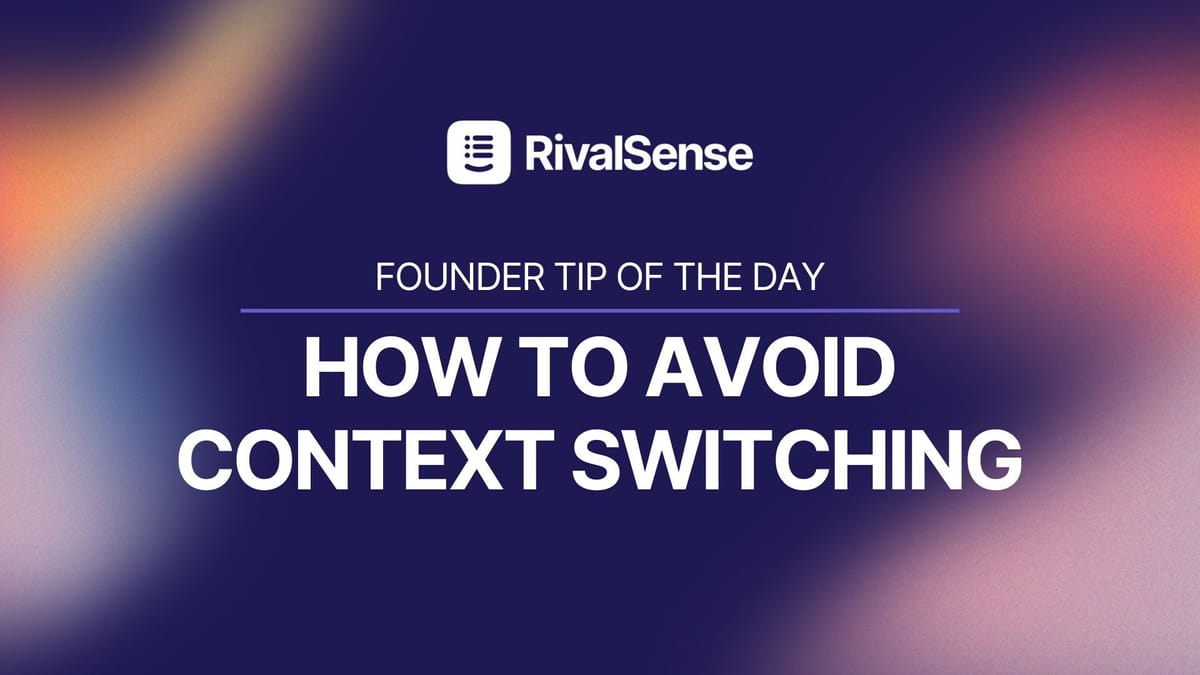Founder Tip of the Day: How to Avoid Context Switching

In today’s dynamic work environment, the ability to multitask and switch between different projects quickly is often seen as a valuable characteristic of a person. The dark reality, however, is that a regular shifting between tasks, also called context switching, is productivity-degrading and something employees should avoid rather than embrace.
What is Context-Switching?
Context switching is when you shift focus from one task to another. This may include checking an email, scrolling through social media, or having a quick call with someone. While we might not notice it, each context switch comes with a cognitive cost that leads to longer task completion time, higher probability of errors, and lowered overall productivity. For example, Gloria Mark, a Professor from the University of California, in 2005 found that it takes an average of 23 minutes and 15 seconds to get back to the task after context switching.

Besides lost productivity, some individuals could also experience increased mental fatigue and reduced creativity due to regular context switching. In the same study by Mark et al. (2005), a test was performed where workers were asked to answer a set of e-mails. One group was left unbothered while the other was constantly interrupted by phone calls and messages from colleagues. They found that people had higher levels of stress, frustration, mental effort, feelings of time pressure, and mental workload when interrupted.
Some Strategies to Avoid Context Switching
1. Identify context switches
This might sound a bit too obvious but to combat context switching you have to first understand what’s causing it and when you are most likely to switch between tasks. Take a day or two to write down every time you switch between a certain task, whether it’s a phone call, an email, or your talkative colleague complaining about some politician. This will allow you to start defending yourself against these interruptions.
2. Set priorities
One of the main reasons individuals usually multitask is because multiple important tasks have to be completed. And to feel like we are addressing them all, we usually try to do a little of each one at once. However, due to the switching costs, in reality, we complete all the tasks slower than if we had focused on each one sequentially. Eisenhower Matrix is one of the tools that can help you identify which tasks you should do first.

3. Set aside time for non-essential tasks
Instead of letting yourself be interrupted every ten to fifteen minutes, set specific time slots for non-essential tasks like checking Slack, e-mail, or having a quick scroll through social media. This will minimize the amount of context switches within the workday. You can, for example, set a 15-20 minute “social check” break in the morning, before lunch, and in the afternoon.
4. Switch to “Do not disturb”
“Do not disturb” should become your favorite Slack and mobile phone function. Regular notifications or phone-buzzing will only tempt you to quickly check the message, even if you already have a specific time set aside for checking the messages.
5. Use productivity tools
Remember that it is easy to use technology to boost your productivity in important ways. There are many different kinds of tools available to help you automate manual tasks. For example, our tool RivalSense can significantly reduce the time you spend on competitor monitoring by sending you weekly curated updates. Rather than everyday checking what your competitors are up to, you can receive short, actionable insights that take you only 5 minutes per week to read.
Of course, you have to be careful not to use too many tools. Like switching between tasks, a shift between tools also takes a mental toll and reduces productivity. If you can integrate some apps into one, that would significantly increase not only your but the whole team’s productivity. RivalSense tries to reduce this impact by integrating competitor news into your daily morning e-mail workflow.
6. Set up no-meeting days
One of the unlucky consequences of the pandemic was that middle managers fell in love with regular meetings. Too often many of these meetings are completely pointless, boring, and are lacking a clear agenda. If you are a manager reading this now, know that your team would appreciate no-meeting days when they can fully focus on the tasks at hand.
Embracing productivity
In today’s dynamic environment, those who are able to focus without unnecessary distractions will have a cognitive advantage over multitaskers. This is largely a mental problem everyone has to embrace, but one that can be easily overcome with the tools available today.

